If you want to get started growing your own Venus Flytrap, then you need to find the perfect soil.
This article will cover the best Venus Flytrap soil and what you need to do to make sure these carnivorous plants will sprout and thrive.
I’ll also show you how to pot and potting techniques. I’ll also share some tips on how to care for the Venus Flytrap as it grows.
Let’s look at what Mother Nature provides as a growing medium for this unusual carnivorous plant.
What Soil is Best for Venus Fly Traps?
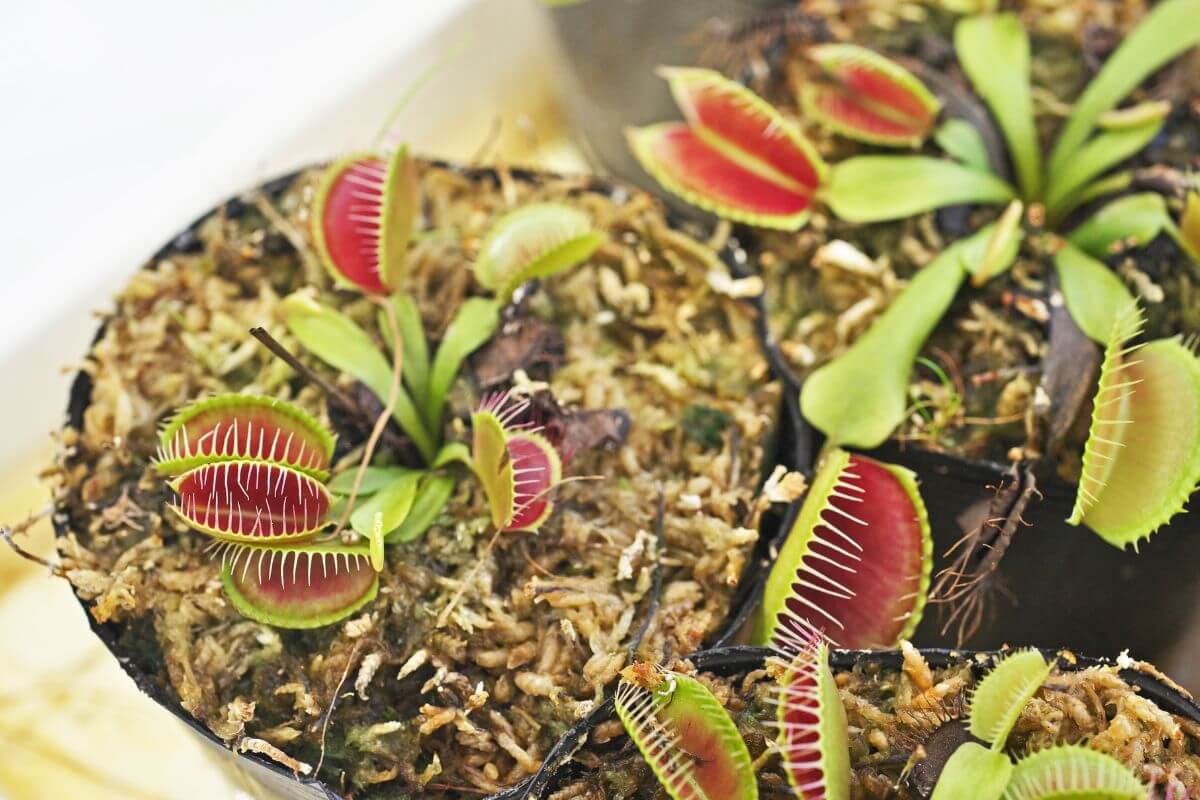
The Venus Flytrap is a very unique plant and calls a very limited geographical area its native habitat. Native to a 100-mile radius from Cape Fear, it grows only in the bogs and wetlands found in the eastern United States coastal states of North and South Carolina where the soil has no nutrients.
The most important characteristic of the Venus fly trap soil bed is that its growing medium must be nutrient-free soil. The growing medium also needs to be well-draining, while still providing for a moist environment for healthy roots.
What type of soil for Venus fly traps is needed? Anything special? Not at all.
Prepackaged soil mixes for carnivorous plants are available for purchase or you can mix your own.
When preparing a growing medium for container cultivation, a combination of peat moss or sphagnum moss blended with perlite or silica sand are excellent options. They’ll combine for a great flytrap potting soil.
The peat moss for Venus fly trap plants will help retain the necessary moisture for healthy growth. On the other hand, the sand or perlite ensures that drainage takes place and provides aeration to prevent the compaction of container soil.
The Venus Fly trap plant cannot absorb and process nutrients available in a soil bed. In their natural habitat, the soil bed is extremely nutrient-poor. Nutrients come from the insects that the traps catch.
- Related articles: How Often Venus Flytraps Feed
To replicate the best growing conditions, you need to use a soil mix that is free of nutrients and minerals. Regular potting soil may already contain nutrients, so you’ll need to double-check the soil you choose.
Drainage and soil aeration both become doubly important because the Venus Flytrap prefers high humidity.
How to Choose the Best Pot for Venus Flytraps
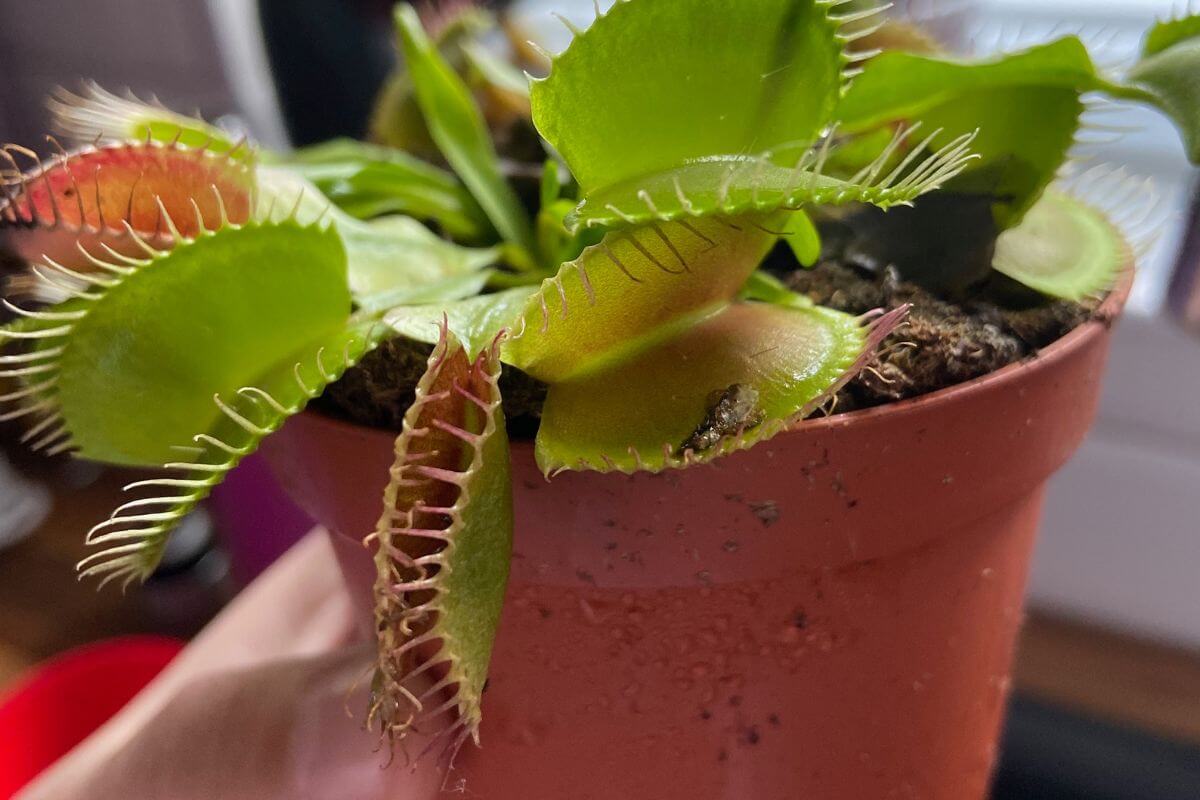
When selecting the perfect container for your Venus Flytrap care, you should take into account the pot size, the material the pot is made of, and the pot’s drainage.
Venus Flytrap Pot Size
To choose the correct pot size for your plant, start by knowing what size the Venus Flytrap plant is. The pot size should match the plant size.
The container’s diameter needs to measure between 2 and 6 inches, depending on the size of your Venus Flytrap. Also, consider the pot’s depth, as this plant does better in taller containers with a depth measuring from 4 to 6 inches.
Venus Flytrap Pot Material
The best pot materials for a Venus Flytrap will be glazed ceramic or plastic. Styrofoam is a viable alternative as well. The reason for using one of these materials is that they provide your plant with insulation.
For example, both metal and glass can be used, but they do not ensure adequate insulation for your plant from extreme temperatures in winter and summer.
Terracotta or clay pots are not recommended because they will wick away moisture that your plant needs.
Venus Flytrap Pot Drainage
As your growing medium must be well-draining, so must your plant’s pot. Make sure your container has drainage holes to allow excess water to drain out of the pot.
Using a container without drainage holes will lead to diseases and infections. When water is trapped in the soil, it often leads to root rot.
Beginner and experienced gardeners of carnivorous plants would be wise to start with a pot with drainage.
How to Make Venus Fly Trap Soil
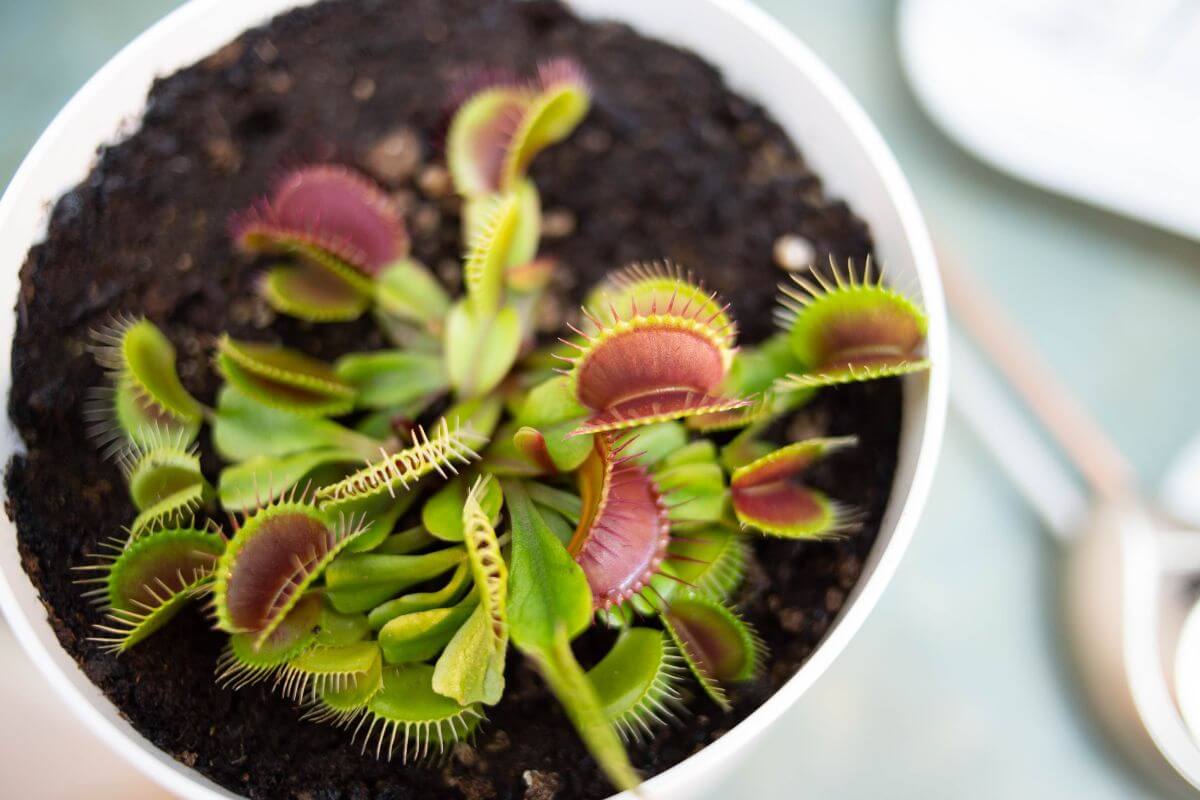
Choose a Venus Flytrap Soil Recipe
One great thing about gardening is that you are free to buy ingredients and mix your own special soil mix or growing medium. This is especially true when cultivating a Venus Flytrap plant.
If you cannot find the pure ingredients at your local nursery or gardening center, look for them at one of the many online gardening supply shops.
Several soil recipes will work well for the cultivation of your Venus Flytrap plant. You can use:
- Blend of peat moss and perlite in a 4 to 1 or 2 to 1 ratio
- Blend of sphagnum moss and perlite in a 4 to 1 or 2 to 1 ratio
- Blend of peat moss and silica sand in a 4 to 1 or 2 to 1 ratio
- Blend of sphagnum moss and silica sand in a 4 to 1 or 2 to 1 ratio
Those are general ratios. The important thing in preparing a Venus Flytrap soil mix is that the moss will be the dominating ingredient with a bit of drainage material (sand or perlite) added in.
When using either peat moss or sphagnum moss, there must be a draining agent blended in, otherwise, your plant is at risk of root rot.
Because the soil must be moist at all times, there is a risk of rotting without proper drainage. The overwatering of this plant is a risk when cultivating.
Also, note that cactus and succulent soil is unsuitable for carnivorous plants.
Avoid Soil Containing Fertilizers
The ingredients you use must be pure. Do not, under any circumstances, use standard or enriched potting soil mixes because of other things they may contain.
When purchasing moss, make sure that it is pure and has not been enriched. With any type of fertilizer or nutrients. This is necessary to ensure the health and well-being of your plant.
Of course, there are exceptions, but usually only with expert carnivore plant growers. They may use extremely diluted fertilizer when needed.
- Related articles: Causes of Unhealthy Venus Flytraps
Best Venus Flytrap Soil and Where to Buy
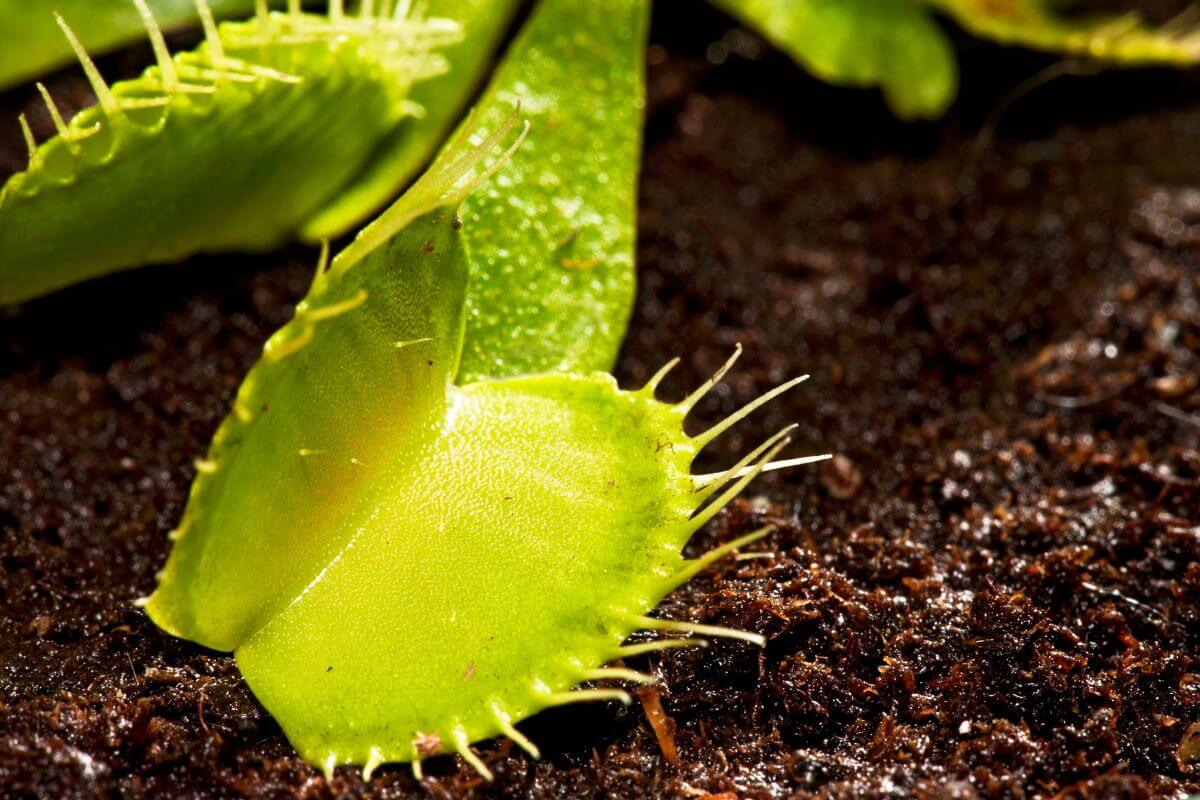
The advantage of buying a ready-made carnivorous plant growing medium is that the ratios of the ingredients will already be correct. It may prove to be more expensive in the long term than mixing your own, but it’s a good start.
There many good soil mixes for carnivorous plants like the Venus Flytrap. Here are some of the best soil for Venus Fly Traps:
1. AK Carnivores Plant Soil Mix
This is a very small sandwich-sized bag of soil specifically blended for carnivorous plants such as the Venus Flytrap, Sarracenia, Pinguicula, and Drosera.
2. Rio Hamza Trading All Natural Carnivorous Plant Soil Mix
A 1-quart small bag of carnivorous plant potting soil. This is a hand-mixed blend of 50% sphagnum peat moss and 50% perlite. It is 100% natural with no additives whatsoever. Ideal for Venus Flytraps, Sundews, Pitcher Plants, and more.
You can also opt to buy the single ingredients to mix your own.
3. GreenA1 Coarse Silica Sand
2 gallons of 100% natural earth sand with the horticultural grade size 12. This sand is cleaned and washed, so it is ready to use directly from the package.
4. Espoma Organic Peat Moss 8-quarts
An all-natural, organic sphagnum peat moss to prevent compaction, while ensuring aeration and drainage, it contains zero additives.
5. Perfect Plants Organic Sphagnum Peat Moss 8-quarts
Offering high absorbency and moisture retention, this organic sphagnum moss is 100% peat moss containing no additives. Ideal for carnivorous plants.
6. 100% Natural Horticultural Perlite
High-quality natural perlite for carnivorous plants, this product is 100% natural with no additives of any kind.
Venus Flytrap Potting Step-by-Step
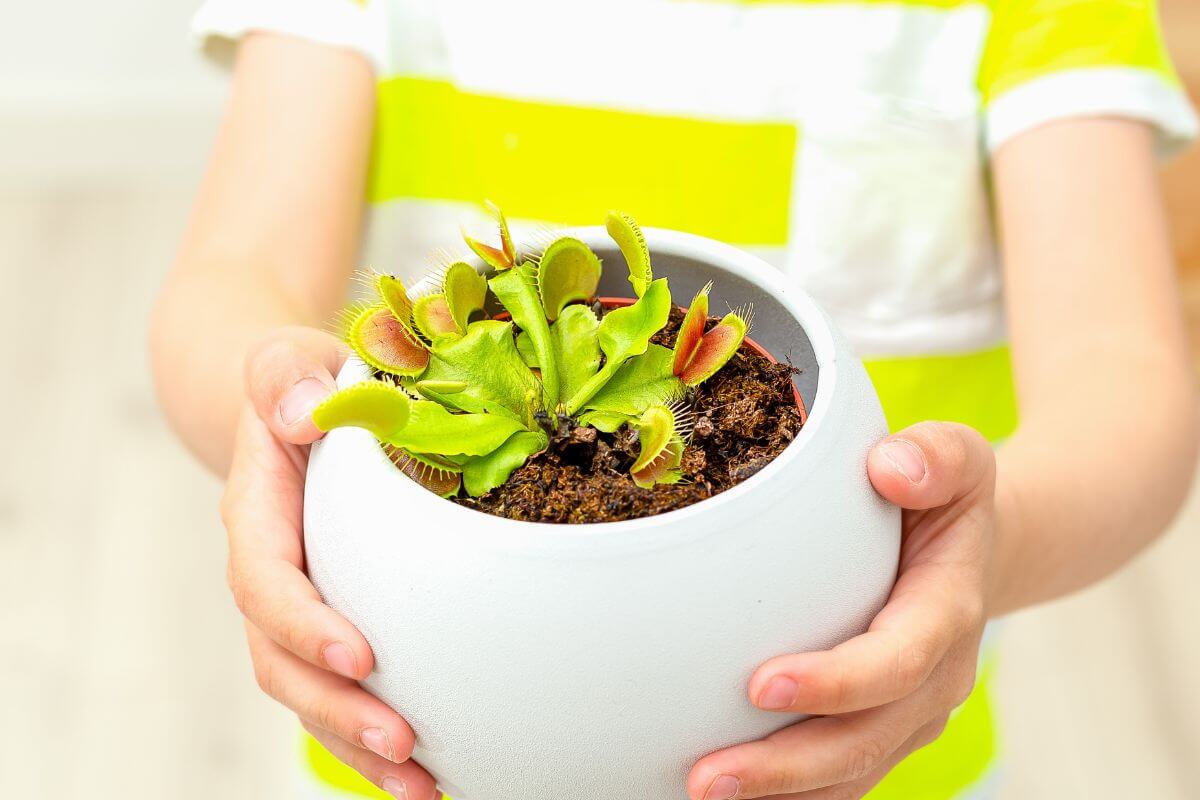
Follow these steps to when potting or repotting a Venus Flytrap:
Step 1: Prepare Your Plant
Your Venus Flytrap plant will most likely be in a small nursery container. Provide your plant with a little distilled water and then gently begin removing the plant from its nursery pot.
Foliage can survive a bit of stress, but the roots are super-delicate, so be gentle when removing your plant.
Step 2: Prepare the Soil
Take your soil mix and moisten it. Now put it in the container. Pat it a bit with your finger or a bonsai shovel, but do not compress it inside the pot. The soil should reach the edge of the pot.
Step 3: Prepare the Potting Hole
Use a long slim tool to prepare a narrow, but deep hole in the Venus fly trap potting soil mix.
Step 4: Position Your Venus Flytrap
Take your plant in hand by holding all the foliage together and guiding your plant from the top of its rhizome. Insert the roots inside the hole you prepared and position the roots as vertically as possible.
Step 5: Stabilize the Plant and Complete Potting
Push the soil around the base of your Venus Flytrap to stabilize it and fill in any spaces in the root hole. The rhizome must also be covered with the growing medium as it should not be exposed to sunlight. Add any extra soil necessary to support and hold the plant in place.
Step 6: Water
Water the plant at the top of its base to aid in keeping the Venus fly trap soil mixture in place.
Your plant is now ready to begin its new cultivation phase. Repotting is often traumatic for plants, so consider that for the first several weeks, your plant may appear a bit weak. Keep the soil bed moist, using only distilled water, filtered / reverse osmosis water, or rainwater.
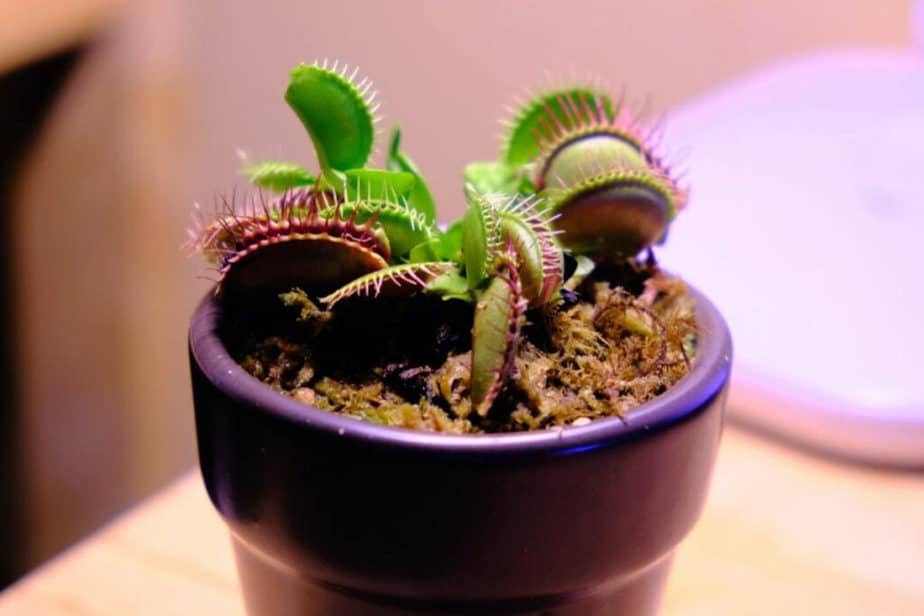
Do not feed your Flytrap for the first two weeks to give it time to adjust. Do not fertilize either.
Make sure your plant has proper lighting with 8 to 12 hours of sunlight daily. In any event, avoid making abrupt changes for your Venus, and do provide a minimum of 6 hours daily of sunlight exposure or a growing light.
Avoid moving your plant around to prevent stressing it.
Extra Tips
- Avoid triggering the flytraps as much as possible. This will aid in saving your plant’s energy.
- Prepare all necessary tools and ingredients before you move your plant to a new pot, so the healthy root isn’t exposed for a long time looking for tools.
- Water appropriately. Overwatering can cause fungus or rot, but the soil must always be moistened, and check the environmental humidity level.
Venus Flytrap Soil Final Thoughts
Soil for Venus Flytrap plants is very important. What soil does Venus flytrap need?
Nutrient-free soil for Venus fly traps is essential. It must also retain moisture, while being well-draining. If the soil is too dry, it will wilt the plant’s traps and leaves. Too wet, and the roots will become soggy and prone to rot.
Check out these other articles to learn more about the Venus Flytrap:







